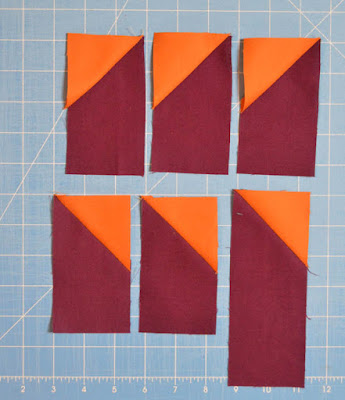We're getting into the Thanksgiving mood this week by sharing three quick projects made using those fun fall palettes from our Painter's Palette Solids collection.
Today is the Harvest Tones Leaf Runner:
Just three blocks--it goes together pretty quickly, and you can sew the whole runner (including binding) from six fat quarters. The runner (or door hanging!) measures 14" x 42"
Let's get started!
You’ll Need:
Six fat quarters: Bronze, Bordeaux, Gold, Old Green, Wasabi,
and Burnt Sienna
½ yard backing fabric
18" x 45" piece of batting
Printer paper or foundation paper
fabric marking pen
Cutting
From each of the background colors (Bronze, Gold, Wasabi):
One 3-1/2” x 10-1/2” strip
One 3-1/2” x 13-1/2” strip
One 1-1/2” x 13-1/2” strip
One 1-1/2” x 14-1/2” strip
One 4-1/2” square
One 4-1/4” square
(2) 2-1/2” x 4-1/2” pieces
(6) 2-1/2” squares
(2) 2-1/2” x 5-1/2” pieces (for paper piecing)
From each of the leaf colors (Bordeaux, Old Green, Burnt
Sienna)
(2) 2-1/4” x 21” strips for binding (you may need one extra
strip total, depending on how you add your binding)
(5) 2-1/2” x 4-1/2” pieces
(2) 4-1/2” squares
(1) 2-1/2” x 6-1/2” piece
(1) 5-1/2” square (for paper piecing)
Click here to download the paper piecing pattern. You’ll
need to print three copies.
Make the Blocks
Note: Sample block made using Bronze and Bordeaux.
Step 1: Draw a diagonal line on the wrong side of each 2-1/2”
Bronze square. Noting orientation in the photo below, lay the marked squares on
the five 2-1/2” x 4-1/2” Bordeaux pieces and the one 2-1/2” x 6-1/2” Bordeaux
piece. Note: Direction of the diagonal line DOES matter!
Step 2: Stitch on the drawn lines, trim seam allowance to ¼”
and press open.
Step 3: Use the (1) 5-1/2” Bordeaux square and the (2) 2-1/2”
x 5-1/2” Bronze pieces with the paper piecing pattern to create the paper
pieced star tip unit. Trim unit ¼” past the solid line and remove paper. Tip:
Don’t forget to set your stitch length shorter when you paper piece!
Step 4: To make the stem unit, draw diagonal lines on the
wrong side of both 4-1/2” Bordeaux squares. Lay the first marked square on the
4-1/4” Gold square as shown, noting where the extra size of the Bordeaux square
is positioned. Stitch on the drawn line, trim the excess, and press open.
Step 5: Repeat with the remaining marked square on the opposite side of the Gold square. Square up unit to measure 4-1/2” if needed.
Step 6: Lay out the units from Step 2, the star tip unit,
and stem unit, and the two 2-1/2” x 4-1/2” Gold pieces as shown to create the
block. Sew the units together as shown to make three separate sections. Join
the bottom two sections and then add the top section to complete the block.
Step 7: Repeat Steps 1-6 to make two additional blocks.
Making the Runner
Step 1: Lay out the one 3-1/2” x 10-1/2” Gold strip, one
3-1/2” x 13-1/2” Gold strip, one 1-1/2” x 13-1/2” Gold strip, and one 1-1/2” x
14-1/2” Gold strip around the Gold/Bordeaux block as shown. Sew each piece on,
beginning with the 3-1/2” x 10-1/2” piece and working your way around the
block. Repeat for the remaining two blocks.
Step 2: Lay out the three bordered blocks as shown. Sew the
blocks together in a row.
Step 3: Layer the runner top with backing and batting and
quilt as desired.
Step 4: Use the (6) 2-1/4” x 21” binding strips to bind the
runner.


















































